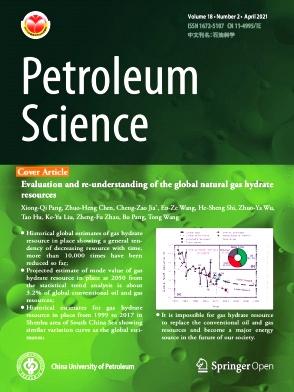Effects of multi-scale wave-induced fluid flow on seismic dispersion, attenuation and frequency-dependent anisotropy in periodic-layered porous-cracked media
IF 6
1区 工程技术
Q2 ENERGY & FUELS
引用次数: 0
Abstract
The wave-induced fluid flow (WIFF) occurring in the ubiquitous layered porous media (e.g., shales) usually causes the appreciable seismic energy dissipation, which further leads to the frequency dependence of wave velocity (i.e., dispersion) and elastic anisotropy parameters. The relevant knowledge is of great importance for geofluid discrimination and hydrocarbon exploration in the porous shale reservoirs. We derive the wave equations for a periodic layered transversely isotropy medium with a vertical axis of symmetry (VTI) concurrently with the annular cracks (PLPC medium) based on the periodic-layered model and anisotropic Biot's theory, which simultaneously incorporate the effects of microscopic squirt fluid flow, mesoscopic interlayer fluid flow and macroscopic global fluid flow. Notably, the microscopic squirt shorten fluid flow emerges between the annular-shaped cracks and stiff pores, which generates one attenuation peak. Specifically, we first establish the stress-strain relationship and pore fluid pressure in a PLPC medium, and then use them to derive the wave equations by means of the Newton's second law. The plane analysis is implemented on the wave equations to yield the analytic solutions for phase velocities and attenuation factors of four waves, namely, fast P-wave, slow P-wave, SV-wave and SH-wave, and the anisotropy parameters can be therefore computed. Simulation results show that P-wave velocity have three attenuation peaks throughout the full frequency band, which respectively correspond to the influences of interlayer flow, the squirt flow and the Biot flow. Through the results of seismic velocity dispersion and attenuation at different incident angles, we find that the WIFF mechanism also has a significant impact on the dispersion characteristics of elastic anisotropy parameters within the low-mid frequency band. Moreover, it is shown that several poroelastic parameters, such as layer thickness ratio, crack aspect ratio and crack density have notable influence on seismic dispersion and attenuation. We compare the proposed modeled velocities with that given by the existing theory to confirm its validity. Our formulas and result can provide a better understanding of wave propagation in PLPC medium by considering the unified impacts of micro-, meso- and macro-scale WIFF mechanisms, which potentially lays a theoretical basis of rock physics for seismic interpretation.
求助全文
约1分钟内获得全文
求助全文
来源期刊

Petroleum Science
地学-地球化学与地球物理
CiteScore
7.70
自引率
16.10%
发文量
311
审稿时长
63 days
期刊介绍:
Petroleum Science is the only English journal in China on petroleum science and technology that is intended for professionals engaged in petroleum science research and technical applications all over the world, as well as the managerial personnel of oil companies. It covers petroleum geology, petroleum geophysics, petroleum engineering, petrochemistry & chemical engineering, petroleum mechanics, and economic management. It aims to introduce the latest results in oil industry research in China, promote cooperation in petroleum science research between China and the rest of the world, and build a bridge for scientific communication between China and the world.
 求助内容:
求助内容: 应助结果提醒方式:
应助结果提醒方式:


